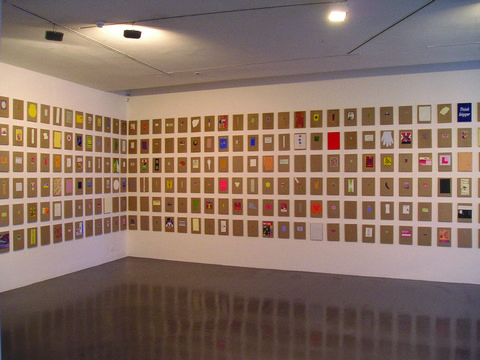
Colin Darke
British, 1957-
The Capital Paintings, 2007
Mixed media
Dimensions variable. 480 paintings, each 11 3/4 x 8 1/4"
Courtesy of the Artist
[How would you define conceptual art?] “Its fundamental definition is work which is the result of the development of ideas, with the making of objects as a secondary, sometimes incidental, activity. Hence Lucy Lippard’s 1973 description of the genre as ‘the dematerialisation of the art
object’.” - Colin Darke
COMMENTS
Colin Darke’s two-part project ‘Capital’ explores price, value, symbolic exchange, and what happens when the ‘ordinary’ is elevated into ‘art’. Part one saw Darke painstakingly transcribe the three volumes of Karl Marx’s Das Kapital onto the surface of 480 two-dimensional objects. The fine, spidery writing, and the nature of the artist’s labour (which is seldom, if ever, valued on a cost-per-hour basis), transformed the detritus of consumer society into something with a quantifiable exchange value, to be exhibited in the rarefied atmosphere of the contemporary gallery, and to be subsequently sold.
Five years later, ‘The Capital Paintings’ completes the transformation of ephemera into art as the artist has painted each object from Capital onto a separate canvas, minus the handwriting, and with that has made the mass-produced unique. This is in the tradition of the readymade, and Darke’s Magic Tree air freshener echoes Duchamp’s urinal, and Koons’ vacuum cleaner; but the sheer volume of paintings (480 canvases) also refers to Marx’s investigations into production and consumption. In addition to the intriguing intellectual conceit at the heart of the project, Darke’s painting also renders these images attractive and desirable commodities in themselves.
- Gemma Tipton, "Colin Darke: The Capital Paintings," Interface Reviews, Web, 30 January 2008
SBMA CURATORIAL LABELS
BORN 1957, ENGLAND
LIVES AND WORKS IN BELFAST
In The Capital Paintings, Colin Darke sheds light on the invisibility of labor, artistic and otherwise. The work consists of 480 small canvases on which the artist painted images of consumer objects including discarded wrappers, store signs, advertisements, and currency. The sheer number of paintings attests to the hours the artist spent making the work. And while each painting signifies the individualized, carefully attentive hand of the artist, the gridded arrangement, identical dimensions of each painting, and consistent presence of raw canvas convey an assembly line-like uniformity. This seeming contradiction between the slow, traditional process of painting and the mechanical reproduction of form evokes the traditions of both the artisan and the factory worker, questioning distinctions between the two.
The Capital Paintings were derived from a previous work titled Capital (2002–03), for which Darke transcribed three volumes of Karl Marx’s massive text, Das Kapital (1867–94). Remarkable in its obsessiveness, Darke’s transcriptions were painstakingly rendered in miniscule handwriting on the small, two-dimensional consumer objects that would become the painted objects of The Capital Paintings.
Labour and Wait, 2013
